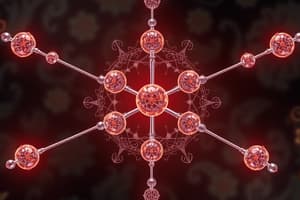Podcast
Questions and Answers
What is a compound?
What is a compound?
- A metal and a non-metal combined.
- A pure substance formed from atoms of two or more elements. (correct)
- A substance that dissolves in a solution.
- A basic attribute you can observe with your senses.
What is an ionic compound?
What is an ionic compound?
A pure substance formed by a non-metal and a metal.
Define a covalent bond.
Define a covalent bond.
A bond formed by the simultaneous attraction of two nuclei for a shared pair of electrons.
What characterizes a molecular compound?
What characterizes a molecular compound?
What is a concentrated solution?
What is a concentrated solution?
What is a mole ratio?
What is a mole ratio?
What is a qualitative property of a solution?
What is a qualitative property of a solution?
Define a solution.
Define a solution.
What is a solute?
What is a solute?
What is a standard solution?
What is a standard solution?
Define a valence electron.
Define a valence electron.
What does the prefix indicate in the name of an organic molecule?
What does the prefix indicate in the name of an organic molecule?
What is a metal?
What is a metal?
Define an electron.
Define an electron.
What is a neutron?
What is a neutron?
Define a proton.
Define a proton.
What is an isotope?
What is an isotope?
What is an ion?
What is an ion?
Define a cation.
Define a cation.
What is an anion?
What is an anion?
Flashcards are hidden until you start studying
Study Notes
Compounds and Bonds
- A compound is a pure substance made from atoms of two or more different elements.
- An ionic compound consists of a non-metal and a metal, forming through electrostatic attraction between oppositely charged ions.
- A covalent bond occurs when two nuclei simultaneously attract a shared pair of electrons, resulting in the formation of molecules.
- A molecular compound is exclusively formed from non-metal elements.
Solutions and Concentrations
- A concentrated solution has a high ratio of solute to solvent, indicating a strong presence of solute particles.
- A solution is a homogeneous mixture where a solute is dissolved in a solvent, leading to uniform distribution of components.
- The solute is the substance that dissolves in a solution, characterized by its bonds being broken by the solvent.
- A standard solution has a known and precise concentration, essential for quantitative chemical analysis.
Chemical Properties and Ratios
- Mole ratio refers to the proportional relationship of coefficients in a balanced chemical equation, crucial for stoichiometry.
- A qualitative property of solution can be observed through the senses, detailing characteristics such as color, taste, and odor.
Atomic Structure and Subatomic Particles
- Valence electrons are found in the outermost energy level of an atom and play a key role in chemical bonding.
- Metals are malleable, ductile, and characterized by good electrical and thermal conductivity, often forming positive ions.
- An electron is a negatively charged particle orbiting the nucleus, essential for chemical reactions and bonding.
- A neutron is a neutrally charged particle located within the atomic nucleus, contributing to atomic mass.
- A proton carries a positive charge and, along with neutrons, forms the nucleus of an atom.
Ions and Their Types
- An isotope is a variant of an element defined by its atomic mass, displaying the same number of protons but differing numbers of neutrons.
- An ion is an atom or group of atoms that has gained or lost electrons, resulting in an electrical charge.
- A cation is a positively charged ion, formed when an atom loses one or more electrons.
- An anion is a negatively charged ion, created when an atom gains one or more electrons.
Studying That Suits You
Use AI to generate personalized quizzes and flashcards to suit your learning preferences.




